Imagine strolling through the park, enjoying the sun’s warm embrace, when you suddenly notice something odd on your beloved dog’s skin. It’s small, raised, and wasn’t there before. What could it be? Is it a wart? A skin tag? Or something far more sinister?
With over 89 million dogs in the United States alone, you’re not the only pet parent to face this predicament. Skin growths are a common concern, affecting most of our furry friends. This article will guide you through identifying and treating these mysterious bumps.
Armed with the knowledge you’ll gain here, you can confidently discern between a harmless skin tag and a bothersome wart. Let’s embark on this journey together for your canine companion’s health and happiness.
What Are Skin Tags?
Dog skin tags are fibrous tissue growths that emerge as dogs age. Composed of collagen proteins, they support organs and systems. Often non-cancerous, these growths have various names, like acrochordons or fibrovascular papillomas. They appear on the surface or below the skin, connected by a stalk-like structure.
Despite their unsightly appearance, dog skin tags are generally harmless. Distinguishing them from other skin anomalies is essential for proper care.
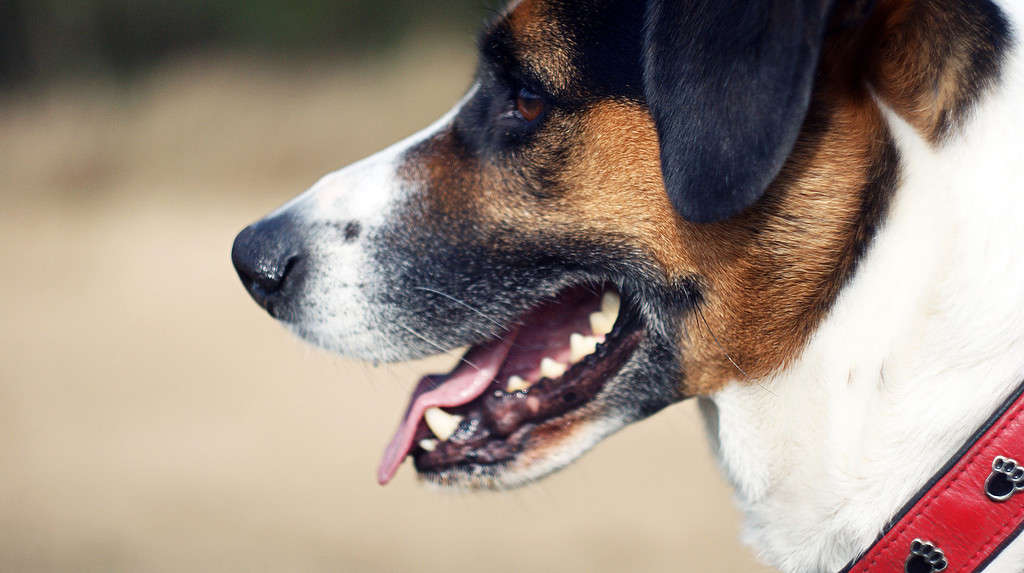
Skin tags, benign growths on a dog’s skin, are commonly harmless and often go unnoticed, but it’s important to monitor their size and location.
©iStock.com/Wirestock
What Are Dog Warts?
Dog warts are peculiar skin growths that can leave pet owners puzzled. These bumps result from a virus invading superficial skin cells, leading to viral papillomas. The virus alters skin tissue growth, causing these unsightly protrusions to appear.
Note that some dog warts are “wart-like” but not virus-related. Older dogs frequently develop such non-viral bumps, which can emerge anywhere on their body. These growths are typically pea-sized, hairless, and firm to the touch. In some cases, they may release waxy debris or even bleed.
What Do Skin Tags Look Like?
Skin tags on dogs can be a bit strange-looking, but they’re usually harmless. They are small flaps of skin, ranging in size from a tiny pen head to three centimeters. Skin tags form when a small bump or gland sticks up from the skin and is rubbed, usually under the arms, in the groin, or around the neck. Because of friction, the flap rises even more and can form into a ball shape.
There are a few kinds of dog skin tags, including fibro adnexal hamartomas, the most common type, and follicular hamartomas, which are less common.
- Fibroadnexal hamartomas look like hairless growths and are what you would normally imagine when considering a skin tag.
- Follicular hamartomas, on the other hand, are flatter and have hair growing from them, and there can be multiple growing together.
Regardless of their appearance, it’s always best to have a veterinarian check out any skin tags to ensure they’re not signs of an underlying health concern.
What Do Dog Warts look like?
Dog warts can be easily identified once you know what to look for. These small growths on the skin are often compared to tiny cauliflower heads with stalks and a rough texture. Some dog warts may appear as hard, scaly plaques, while others may be hard masses growing inward. Not all growths on your dog’s body are warts.
Some may be more serious issues requiring prompt attention from a veterinarian. These warts can occur anywhere on your dog’s body but are most commonly found on the face, neck, and dog paws.
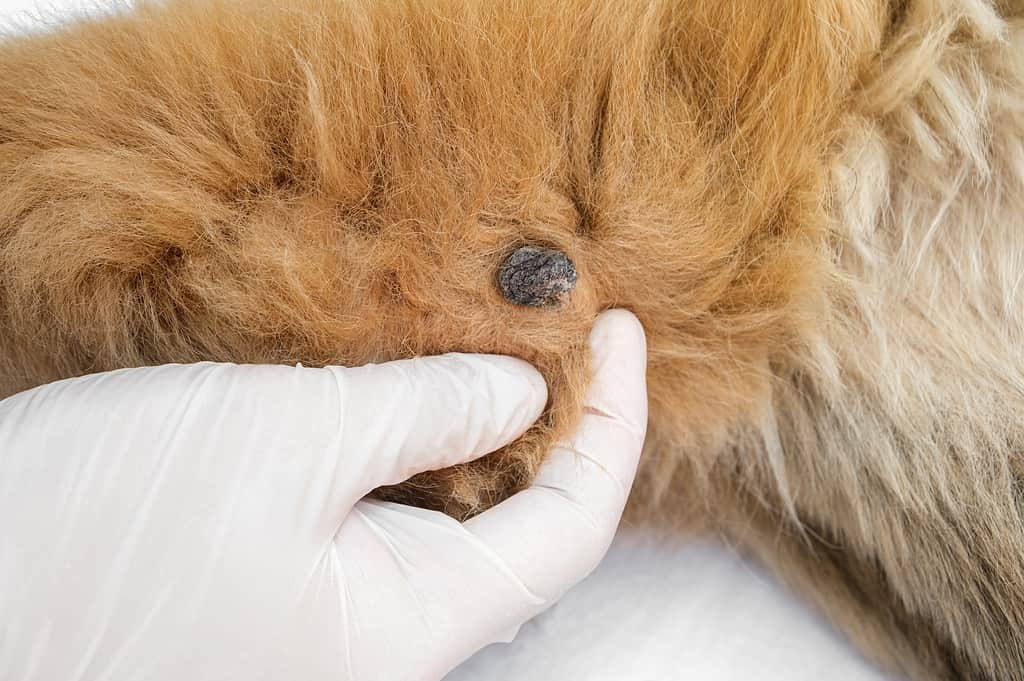
Dog warts appear as small, raised growths on a dog’s skin. These benign viral infections are typically harmless and often resolve on their own. However, it’s advised to consult a veterinarian for proper diagnosis.
©iStock.com/Snizhana Galytska
Symptoms of Skin Tags in Dogs
Skin tags in dogs are slow-growing. They can take a while to become noticeable. They are found on or just under the skin’s surface and vary in size and appearance. Although not dangerous, they can cause issues if they grow too large or are located in a spot that affects your dog’s daily activity.
If they become damaged, skin tags can bleed and potentially become infected. Your dog may have a skin tag if they exhibit any of the following symptoms:
- Growth with a stalk-like appearance
- Growths with a wart-like surface
- Multiple growths or a single growth
- Growths that include hair follicles
- Plaque-like flattened growths
- Growths that bleed when damaged
Symptoms of Dog Warts
When it comes to dog warts, they can take on various appearances. While some may have a distinct look, others can be tricky to identify. Generally, warts are raised and knobbly and feel soft-to-firm to the touch.
If you spot warts around your dog’s mouth, they might resemble a ‘cauliflower’ or ‘sea anemone.’ It’s not uncommon to mistake skin warts for ticks, but there are distinguishing factors. Ticks are usually purplish and have a narrow base where their mouthparts are buried in the skin.
However, warts can be pink, white, or grey, have a wider base, or be almost flat. Some types of dog warts can grow over two centimeters in diameter. Certain body areas are more prone to warts caused by different papillomaviruses.
Younger dogs are more susceptible to canine oral papillomas caused by CPV-1, which appear suddenly in clusters around the mouth, muzzle, eyes, or between the toes and spread rapidly.
Symptoms of dog warts include:
- A rough patch of pink-to-white skin
- Darker, lumpy appearance resembling cauliflower
- Single or multiple eruptions
- Excessive licking or scratching
- Bleeding or oozing from the wart
What Causes Skin Tags in Dogs?
Skin tags in dogs can be an unsightly for many pet owners. These small, fleshy growths on your furry friend’s skin often raise questions about what causes them. Although veterinarians have several theories, the actual reasoning behind why dogs develop skin tags has yet to be entirely known.
- One suggests skin tags form due to friction, chronic irritation, or trauma. This means you’ll typically spot skin tags in areas with skin folds, creases, and pressure points like elbows.
- Another theory suggests that skin tags form due to the overactivity of cells called fibroblasts, producing fibers and collagen.
- Lastly, bathing your dog too much can dry out its skin and cause a tag to form. If you notice any skin tags on your dog, it’s best to take them to the vet for proper diagnosis and treatment.
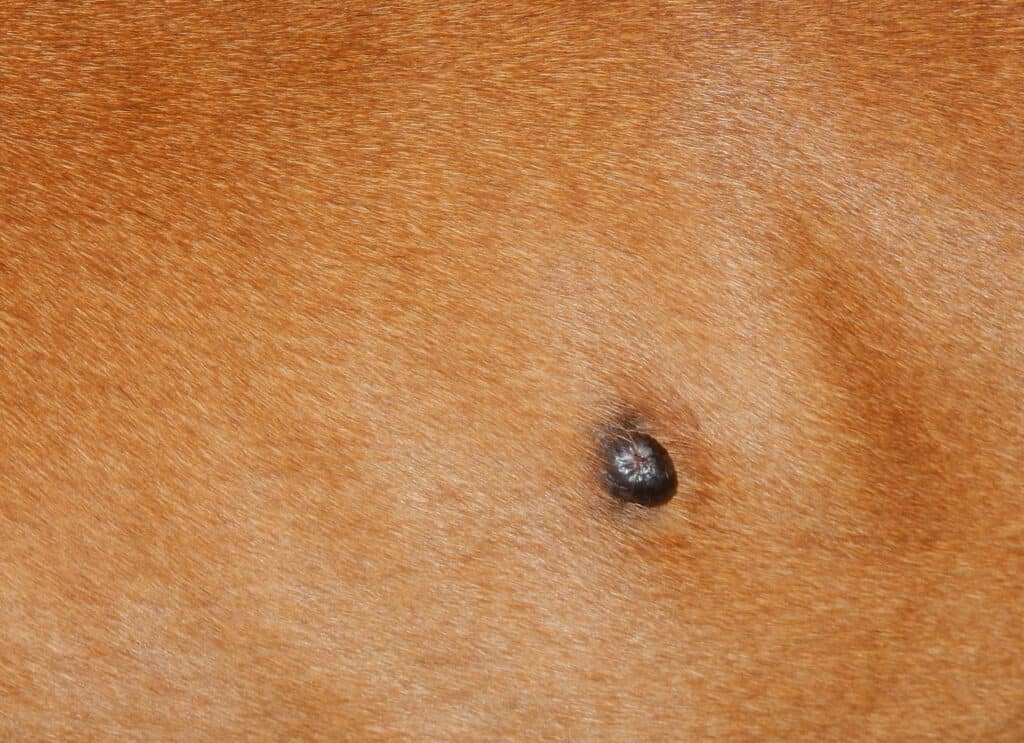
Skin tags in dogs can be caused by various factors, including genetics, age-related changes, and constant friction.
©iStock.com/Chellym
What Causes Dog Warts?
Dog warts, also known as papillomas, are caused by a virus and are usually harmless. But just like humans can catch warts from HPV, dogs can carry their papillomaviruses, called CPVs. Once a dog recovers from a CPV, they become immune to that specific type, but it could still develop other types of CPV.
While some animals may carry these viruses without showing any symptoms, young or immunocompromised dogs may develop warts until their body builds up a strong enough immune response to fight them off.
These pesky viruses can survive for a long time in the environment and gain access when your dog’s skin becomes damaged, like an insect bite or abrasion. They can spread easily through direct contact with another dog with a wart or contaminated equipment like bedding or food bowls.
How Are Skin Tags in Dogs Diagnosed?
As pet parents, we want our furry companions to live long and healthy lives. Unfortunately, aging dogs can develop skin tags that may signal more serious health issues.
So, how do you know if a skin tag is just a harmless bump or something more problematic? Keep an eye on the growth’s location, size, and appearance, and snap some pictures with an object of known size next to it.
And remember, don’t whip out the scissors or razors. Use electric clippers to avoid any accidental injuries. If the growth is dark-colored, near sensitive areas, or rapidly growing, seek medical attention ASAP. Also, look for changes in your pup’s appetite, energy levels, weight, vomiting, or discomfort.
How Are Dog Warts Diagnosed?
As much as we adore our dogs, we know they’re not invincible to health issues – dog warts are common. But how can you tell if that bump on your pup’s skin is something to worry about? Generally, a veterinarian can diagnose a dog wart during a physical examination. And if they need further confirmation, they might take a tissue sample and send it to a lab for testing.
But don’t worry; this is routine and painless for your dog. Spotting a dog wart early is crucial in getting your pup the right treatment.
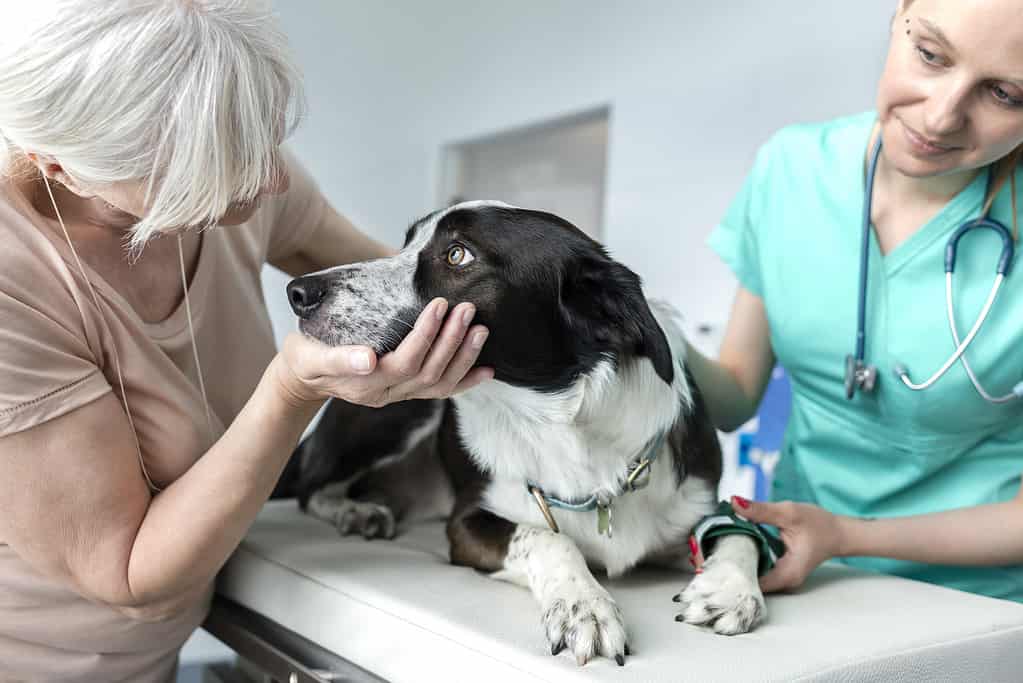
Veterinarians use a hands-on approach to diagnose dog warts, carefully examining the dog’s skin for characteristic features.
©iStock.com/IPGGutenbergUKLtd
How to Treat Skin Tags in Dogs?
While most skin tags don’t cause any harm to your furry friend, sometimes removal can be recommended by your vet. One option for removal is surgery, but this is usually only necessary if the tag is causing problems such as infections, pain, or physical discomfort.
Another removal method is cryosurgery, where the unwanted tissue is frozen with nitrous oxide or liquid nitrogen and will fall off or dissolve within four weeks. This process is less invasive and may only require mild local anesthesia, which is great news for dogs at an increased risk of complications during anesthesia.
Recovery is typically painless, and sometimes multiple treatments may be necessary for complete removal.
How to Treat Dog Warts?
Dog warts can be quite the nuisance, but thankfully, they often clear up within six to eight weeks as your dogs’s immune system fights them off. However, sometimes a visit to the vet becomes necessary:
- Warts may become too numerous or large or cause secondary issues like lameness, eating difficulties, or eye irritation.
- When warts bleed or get infected with bacteria, it’s time for action.
- Rarely, untreated warts might turn into cancerous tumors, so treat warts lingering for over three to five months.
Dogs on immunosuppressive meds or with other health conditions may struggle to ditch these pesky warts. For a few troublesome warts, surgical removal (scalpel, laser, or cryosurgery) is the way to go.
Medications might be needed if lots of warts are causing your dog grief. Vets have tried treatments like:
- Interferon
- Imiquimod
- Cimetidine
- Azithromycin
- Immunostimulation
- Reducing immunosuppression
Always consult your vet to determine the best course of action for your pup’s well-being.
How To Get Rid of Skin Tags On Dogs?
Getting rid of skin tags on your pooch isn’t always a must, but sometimes it’s the right call. For example, if your dog can’t stop rubbing, scratching, or gnawing at their skin tags, it’s time to step in. Removing them prevents irritation, bleeding, and potential infection. Also, if skin tags cause discomfort or hinder movement, it’s smart to take action.
Your vet might propose a minor surgical procedure using local or total anesthesia for a more relaxed pup. Alternatively, they could recommend laser surgery to keep bleeding to a minimum.
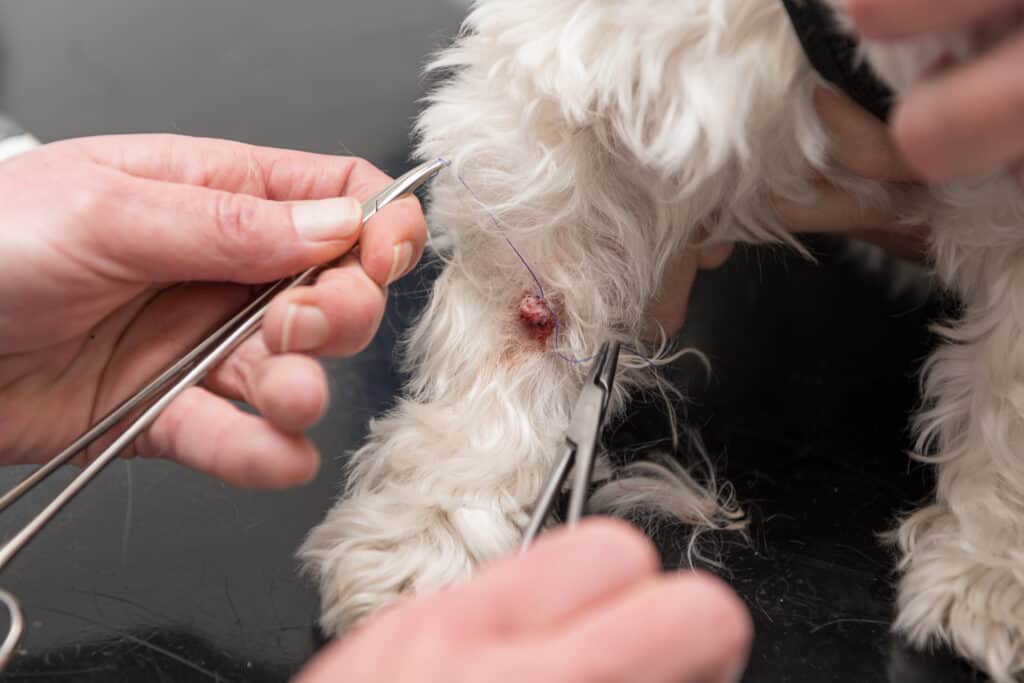
Learn effective ways to eliminate skin tags on dogs. Veterinary options include surgical removal or non-surgical methods.
©iStock.com/K_Thalhofer
How To Get Rid of Dog Warts?
Tackling dog warts can be a piece of cake if you follow the right steps. Don’t dilly-dally; try this pain-free method using apple cider vinegar (ACV). Though it may cause mild tingling, ACV effectively destroys warts. Remember, never use ACV near your dog’s eyes or genitals. Here’s the scoop:
- Pour some ACV into a clean cup.
- Apply petroleum jelly around the wart to shield unaffected skin.
- Position your dog so warts face upward.
- Use a sterilized eyedropper to add two to three drops of ACV to each wart.
- Let the ACV work its magic and wipe off any excess with a paper towel.
- Keep your dog occupied and still for 10 minutes to let the ACV fully soak in.
- Repeat this routine three to four times daily until the wart dries up and falls off, root included.
- Clean the area with a washcloth as the root dries and a blister or red spot appears.
Remember, the top of the wart may fall off first, causing the ACV to sting a bit. Keep applying the ACV three to four times daily until the treatment reaches the wart’s root. With these steps, your dog will be wart-free in no time.
Can Skin Tags on Dogs Be Avoided?
Preventing skin tags on dogs is not always feasible, but that’s no reason to despair. These benign growths are usually harmless, so there’s no need for concern.
If you have a big dog or a giant breed and notice skin tags cropping up in areas of friction, ensure your furry pal has well-padded rest spots to minimize the pressure and rubbing that lead to skin tags. If your dog does develop one, don’t panic.
Instead, examine it carefully to confirm it’s a skin tag, not another, more dangerous growth. Your dog can live a healthy and happy life with proper care and attention despite the occasional skin tag.
Can Dog Warts Be Avoided?
Dodging dog warts or viral papillomas is no walk in the park, especially since there’s no vaccine available. To curb the virus transmission risk, limiting your pup’s interactions with other dogs is wise.
If that’s not an option, maintaining clean skin and coat can help lessen the chances of developing sebaceous growths as they age. Moreover, have your veterinarian take a gander if any new lumps or bumps pop up. Early detection is key in addressing any skin issues that might arise.
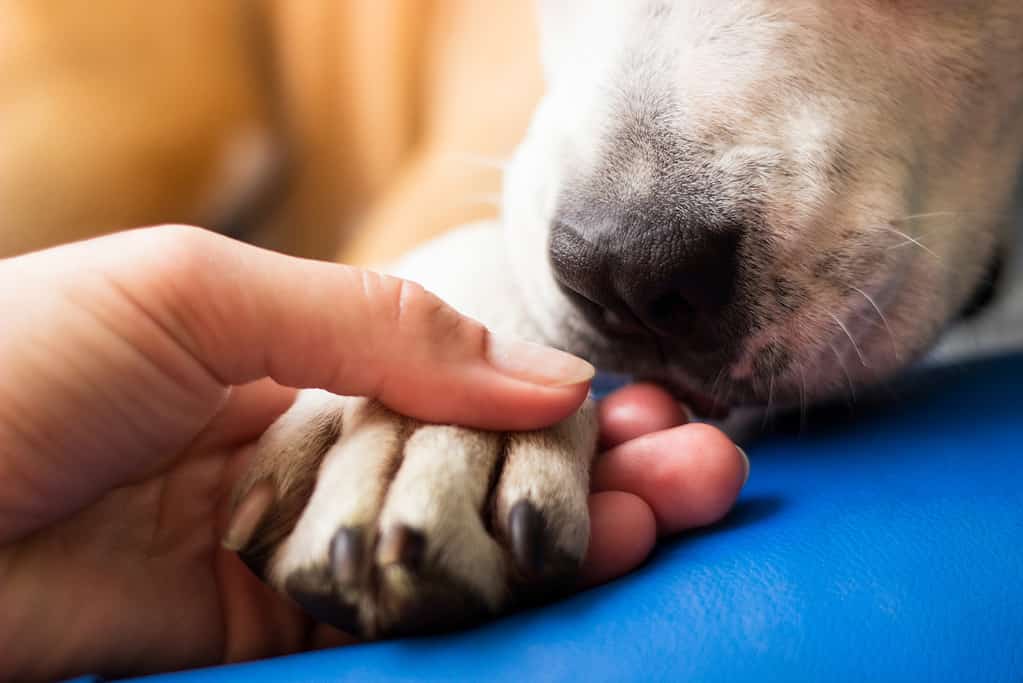
While not entirely preventable, there are steps you can take to potentially reduce the risk of dog warts.
©iStock.com/sanjagrujic
Dog Skin Tags vs. Warts Overview: A Side-by-Side Comparison
As a dog owner, you must know the difference between these little growths. So, let’s break it down in a way that’s easy to understand:
Skin Tags:
- Thin and attached through a slender stalk
- Flat appearance, as if the skin’s been pinched together
- They might resemble warts, making it tricky to tell them apart
- Non-contagious to other dogs or humans
- Not cancerous
Warts:
- Contagious, frequently seen in young and older dogs
- Protruding from the skin, often clustered together
- Jagged, cauliflower-like appearance
- Found on lips, eyelids, mouth, paws, and genital area
- May clear up on their own but often require various treatments
- Non-contagious to humans
- Not cancerous
Even though skin tags and warts share some similarities, like protruding from the skin and being non-cancerous, they have key differences. Warts are contagious, cluster, and exhibit a jagged texture, while skin tags are thin, flat, and may resemble warts. Consult your vet for an accurate diagnosis and treatment plan, especially since many growths can look alike. With this knowledge, you’ll be better equipped to tackle any skin issues your pup faces.
Take the Right Steps for Your Dogs Health
Identifying the distinction between dog warts and skin tags is vital for proper treatment and care. While both growths are non-cancerous, warts are contagious and often cluster, while skin tags are thin, flat, and may resemble warts.
Seek professional advice from your veterinarian when you detect abnormalities on your furry companion’s skin for accurate diagnosis and appropriate treatment options. By staying informed, vigilant, and proactive, you’ll keep your furry friend happy and healthy, enjoying a lifetime of love, cuddles, and adventures.
The photo featured at the top of this post is © iStock.com/Snizhana Galytska
Ready to discover the top 10 cutest dog breeds in the entire world?
How about the fastest dogs, the largest dogs and those that are -- quite frankly -- just the kindest dogs on the planet? Each day, AZ Animals sends out lists just like this to our thousands of email subscribers. And the best part? It's FREE. Join today by entering your email below.
Thank you for reading! Have some feedback for us? Contact the AZ Animals editorial team.







